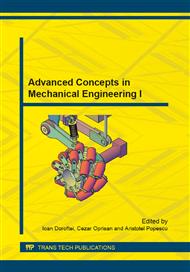[1]
B. Waterman, B. Owens, S. Davey, M. Zacchilli and P.J. Belmont Jr., The epidemiology of ankle sprains in the United States, The Journal of Bone & Joint Surgery, 92 (2010) 2279-2284.
DOI: 10.2106/jbjs.i.01537
Google Scholar
[2]
J. Yoon, J. Ryu and K.B. Lim, A novel reconfigurable ankle rehabilitation robot for various exercises, Robotics and Automation (2005), 2290-2295.
Google Scholar
[3]
M. Girone, G. Burdea, M. Bouzit, V. Popescu and J.E. Deutsch, A Stewart platform-based system for ankle telerehabilitation, Autonomous Robots, 10 (2001) 203-212.
DOI: 10.1023/a:1008938121020
Google Scholar
[4]
P.K. Jamwal, S. Xie and K.C. Aw, Kinematic design optimization of a parallel ankle rehabilitation robot using modified genetic algorithm, Robotics and Autonomous Systems, 57 (2009) 1018- 1027.
DOI: 10.1016/j.robot.2009.07.017
Google Scholar
[5]
P.K. Jamwal, S.Q. Xie, Y.H. Tsoi and K.C. Aw, Forward kinematics modelling of a parallel ankle rehabilitation robot using modified fuzzy inference, Mechanism and Machine Theory, 45 (2010), 1537- 1554.
DOI: 10.1016/j.mechmachtheory.2010.06.017
Google Scholar
[6]
S.M.M. Rahman and R. Ikeura, A novel variable impedance compact compliant ankle robot for overgroud gait rehabilitation and assistance, Procedia Engineering, 41 (2012) 522-531.
DOI: 10.1016/j.proeng.2012.07.207
Google Scholar
[7]
J.W. Wheeler, An ankle robot for a modular gait rehabilitation system, IEEE/RSJ International Conference, 2 (2004) 1680-1684.
Google Scholar
[8]
S. Pittaccio and S. Viscuso, An EMG- Controlled SMA device for the rehabilitation of the ankle joint in post-acute stroke, Journal of materials engineering and performance, 20 (2011) 666-670.
DOI: 10.1007/s11665-010-9826-7
Google Scholar
[9]
D.P. Ferris, K.E. Gordon, G.S. Sawicki and A. Peethambaran, An improved powered ankle-foot orthosis using proportional myoelectric control, Gait& Posture, 23 (2006) 425-428.
DOI: 10.1016/j.gaitpost.2005.05.004
Google Scholar
[10]
A. Cullell, J.C. Moreno, E. Rocon, A. Forner-Cordero and J.L. Pons, Biologically based design of an actuator system for a knee-ankle-foot orthosis, Mechanism and Machine Theory, 44 (2009), 860-872.
DOI: 10.1016/j.mechmachtheory.2008.04.001
Google Scholar
[11]
I.M. Babes (Petre) and I. Deaconescu, Research concerning pneumatic muscle actuated rehabilitation equipment of bearing joints, Dissertation, , Transilvania" University of Brasov, (2012).
Google Scholar
[12]
A. Agrawal, S. K. Banala, S. K. Agrawal and S.A. Binder –Macleod, Design of a two degree-of-freedom ankle-foot orthosis for robotic rehabilitation, International Conference on Rehabilitation Robotics, 9 (2005) 41-44.
DOI: 10.1109/icorr.2005.1501047
Google Scholar
[13]
A. Patar, N. Jamlus, K. Makhtar, J. Mahmud and T. Komeda, Development of dynamic ankle foot orthosis for therapeutic application, Procedia Engineering, 41 (2012) 1432-1440.
DOI: 10.1016/j.proeng.2012.07.332
Google Scholar
[14]
H. Lee, P. Ho, M. A. Rastgaar, H.I. Kregbs and N. Hogan, Multivariable static ankle mechanical impedance with relaxed muscles, Journal of Biomechanics, 44 (2011) 1901-(1908).
DOI: 10.1016/j.jbiomech.2011.04.028
Google Scholar
[15]
H. Kazerooni, J.L. Racine, L. Huang and R. Steger, On the control of the Berkeley lower extremity exoskeleton (BLEEX), International Conference on Robotics and Automation, 2005, pp.4353-4360.
DOI: 10.1109/robot.2005.1570790
Google Scholar
[16]
S.K. Banala, S. Hun Kim, S.K. Agrawal and J.P. Scholz, Robot assisted gait training with active leg exoskeleton (ALEX), Neural Systems and Rehabilitation Engineering, 1 (2009) 2-8.
DOI: 10.1109/tnsre.2008.2008280
Google Scholar
[17]
J.F. Venema, R. Kruidof, E.E.G. Hekman, R. Ekkelenkamp, E.H.F. Van Asseldonk and H. van der Hooij, Design and evaluation of the LOPES exoskeleton robot for interactive gait rehabilitation, Neural Systems and Rehabilitation Engineering, 3 (2007).
DOI: 10.1109/tnsre.2007.903919
Google Scholar
[18]
A. -M. Amancea, I. Doroftei, A. Barnea, F. Adascalitei, Design and Implementation of a Mechatronic System for Lower Limb Medical Rehabilitation, International Journal of Modern Manufacturing Technologies, 4: 2 (2012) 17-22.
Google Scholar
[19]
A. -M. Amancea, I. Doroftei, A. Barnea, B. Bou-Said, Real-Time Monitoring of the Patient Recuperative Progress Using a New Lower Limb Rehabilitation System, Robotica & Management, 17: 2 (2012) 5-10.
Google Scholar


